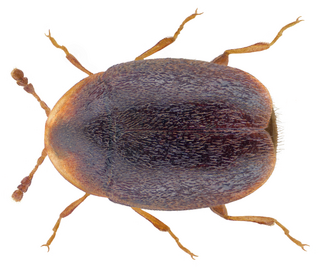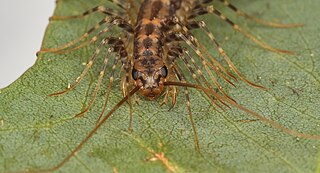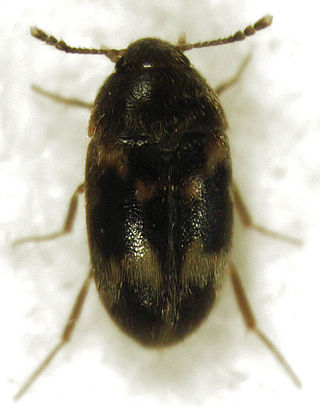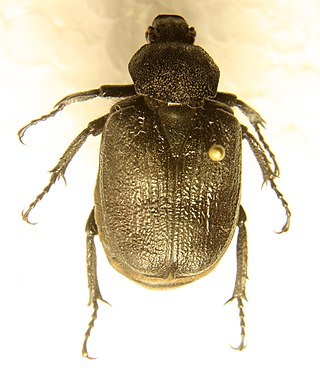
The Japanese beetle is a species of scarab beetle. Due to the presence of natural predators, the Japanese beetle is not considered a pest in its native Japan, but in North America and some regions of Europe, it is a noted pest to roughly 300 species of plants. Some of these plants include rose bushes, grapes, hops, canna, crape myrtles, birch trees, linden trees, and others.

Pauropoda is a class of small, pale, millipede-like arthropods in the subphylum Myriapoda. More than 900 species in twelve families are found worldwide, living in soil and leaf mold. Pauropods look like centipedes or millipedes and may be a sister group of the latter, but a close relationship with Symphyla has also been posited. The name Pauropoda derives from the Greek pauros and pous or podus, because most species in this class have only nine pairs of legs as adults, a smaller number than those found among adults in any other class of myriapods.

Picea abies, the Norway spruce or European spruce, is a species of spruce native to Northern, Central and Eastern Europe.

The Asian long-horned beetle, also known as the starry sky, sky beetle, or ALB, is native to the Korean Peninsula, northern and southern China, and disputably in northern Japan. This species has now been accidentally introduced into the eastern United States, where it was first discovered in 1996, as well as Canada, and several countries in Europe, including Austria, France, Germany, Italy and UK.

The Greater Yellowstone Ecosystem (GYE) is one of the last remaining large, nearly intact ecosystems in the northern temperate zone of the Earth. It is located within the northern Rocky Mountains, in areas of northwestern Wyoming, southwestern Montana, and eastern Idaho, and is about 22 million acres (89,000 km2). Yellowstone National Park and the Yellowstone Caldera 'hotspot' are within it.

Histeridae is a family of beetles commonly known as clown beetles or hister beetles. This very diverse group of beetles contains 3,900 species found worldwide. They can be easily identified by their shortened elytra that leaves two of the seven tergites exposed, and their geniculate (elbowed) antennae with clubbed ends. These predatory feeders are most active at night and will fake death if they feel threatened. This family of beetles will occupy almost any kind of niche throughout the world. Hister beetles have proved useful during forensic investigations to help in time of death estimation. Also, certain species are used in the control of livestock pests that infest dung and to control houseflies. Because they are predacious and will even eat other hister beetles, they must be isolated when collected.

A bark beetle is the common name for the subfamily of beetles Scolytinae. Previously, this was considered a distinct family (Scolytidae), but is now understood to be a specialized clade of the "true weevil" family (Curculionidae). Although the term "bark beetle" refers to the fact that many species feed in the inner bark (phloem) layer of trees, the subfamily also has many species with other lifestyles, including some that bore into wood, feed in fruit and seeds, or tunnel into herbaceous plants. Well-known species are members of the type genus Scolytus, namely the European elm bark beetle S. multistriatus and the large elm bark beetle S. scolytus, which like the American elm bark beetle Hylurgopinus rufipes, transmit Dutch elm disease fungi (Ophiostoma). The mountain pine beetle Dendroctonus ponderosae, southern pine beetle Dendroctonus frontalis, and their near relatives are major pests of conifer forests in North America. A similarly aggressive species in Europe is the spruce ips Ips typographus. A tiny bark beetle, the coffee berry borer, Hypothenemus hampei is a major pest on coffee plantations around the world.

The mountain pine beetle is a species of bark beetle native to the forests of western North America from Mexico to central British Columbia. It has a hard black exoskeleton, and measures approximately 5 millimetres, about the size of a grain of rice.

Cleridae are a family of beetles of the superfamily Cleroidea. They are commonly known as checkered beetles. The family Cleridae has a worldwide distribution, and a variety of habitats and feeding preferences.

Corylophidae is a family of minute hooded beetles, sometimes called minute fungus beetles, in the superfamily Coccinelloidea. There are about 18 genera and at least 120 described species in Corylophidae. They feed on microfungi such as molds, and are often found associated with bark, as well as in leaf litter and other decaying vegetation. In older literature, the family name was often given as Orthoperidae.

Populus tremuloides is a deciduous tree native to cooler areas of North America, one of several species referred to by the common name aspen. It is commonly called quaking aspen, trembling aspen, American aspen, mountain or golden aspen, trembling poplar, white poplar, and popple, as well as others. The trees have tall trunks, up to 25 metres tall, with smooth pale bark, scarred with black. The glossy green leaves, dull beneath, become golden to yellow, rarely red, in autumn. The species often propagates through its roots to form large clonal groves originating from a shared root system. These roots are not rhizomes, as new growth develops from adventitious buds on the parent root system.

Scutigeromorpha is an order of centipedes also known as house centipedes. These centipedes are found in the temperate and tropical parts of every continent except Antarctica, with their distribution significantly expanded by the introduction of the Mediterranean species Scutigera coleoptrata throughout Europe, Asia, and North America. The common species S. coleoptrata is a typical representative of this order, lying in wait for other arthropods, then seizing prey using great speed, and all species in this order reflect adaptations for this mode of life.

Bothrideridae is a family of beetles in the superfamily Coccinelloidea. They are known commonly as the cocoon-forming beetles or dry bark beetles. They occur worldwide with most native to the Old World tropics. In older literature, the family was often included in the family Colydiidae, but is now considered unrelated.

Laemophloeidae, "lined flat bark beetles," is a family in the superfamily Cucujoidea characterized by predominantly dorso-ventrally compressed bodies, head and pronotal discs bordered by ridges or grooves, and inverted male genitalia. Size range of adults is 1–5 mm (0.04–0.2 in) in length. Currently, it contains 40 genera and about 450 species, and is represented on all continents except Antarctica; species richness is greatest in the tropics.

The Mycetophagidae or hairy fungus beetles are a family of beetles in the superfamily Tenebrionoidea. The different species are between 1.0 and 6.5 mm in length. The larvae and adults live in decaying leaf litter, fungi, and under bark. Most species feed on fungi. Worldwide, the 18 genera contain around 200 species.

Tyrpophloeus is a genus of bark beetles. About 12 species comprise the genus, ranging from North America to Europe and Asia. The genus is little-known, but T. populi has recently become important as the causative agent of sudden aspen decline.

Chrysomela is a genus of leaf beetles found almost throughout the world, but not in Australia. It contains around 40 species, including 7 in eastern and northern Europe. It also includes at least 17 species in North America, including the cottonwood leaf beetle Chrysomela scripta.
Dendrophagus cygnaei is a species in the family Silvanidae, in the order Coleoptera ("beetles"). Dendrophagus cygnaei is found in North America.

Osmoderma scabrum, or the rough hermit beetle, is a species in the family Scarabaeidae, in the order Coleoptera ("beetles"). Occurring in eastern North America from Quebec south to Tennessee, it is 14-20 mm long and black, sometimes with a metallic sheen. Adults are nocturnally active and may be found at sap flows or under bark.
Trypophloeus striatulus, the willow bark beetle, is a species of typical bark beetle in the family Curculionidae.

















